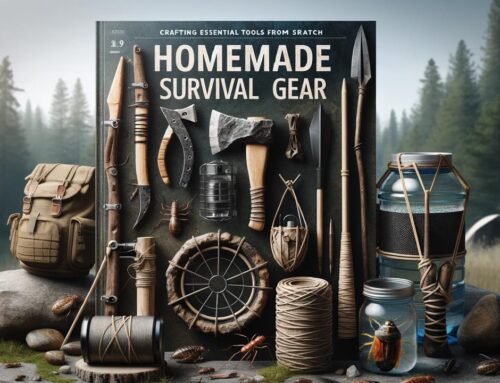DIY Gear for Food and Water
“DIY Gear for Food and Water” is a crucial guide that empowers you with the knowledge to craft essential tools using minimal resources. It covers innovative methods to purify and collect water, such as turning a plastic bottle into a water filter or constructing a solar still. For food acquisition, it delves into the art of making simple yet effective tools like deer bone or wire fish hooks, and elaborates on building fish traps and survival nets. These tools are not just practical but also instill a deeper connection with nature. The guide is replete with step-by-step instructions, ensuring that even novices can master these vital skills. Whether it’s purifying water from natural sources or catching fish and small game, this comprehensive guide is indispensable for anyone looking to thrive in the wilderness with self-reliance and ingenuity.
The DIY Survival Gear Ideas Series
Table of Contents
- Plastic Bottle Water Filter
- Solar Still
- Water Distiller
- Deer Bone Fish Hook
- Wood, Wire or Nail Fishing Hook
- Fish Trap
- Survival Net
- Animal Traps and Snares
- Grasshopper Trap
- Frequently Asked Questions
- The DIY Survival Gear Ideas Series
Plastic Bottle Water Filter
Creating a water filter using a plastic bottle is a practical and efficient way to purify water in survival situations. Here’s how to make it:
- Materials Needed: A plastic bottle, a cloth or coffee filter, charcoal, sand, and gravel.
- Preparing the Bottle: Cut the bottom of the bottle off and turn it upside down.
- Layering the Filter: Place the cloth or coffee filter inside the bottle neck. Add a layer of activated charcoal (from campfire remains or similar), followed by layers of sand and gravel.
- Using the Filter: Pour water into the top of the bottle and let it drip through the layers. Each layer helps remove impurities, with the charcoal layer being especially effective for removing pathogens and odors.
- Final Purification Step: While this filter will remove many impurities, it’s recommended to boil the water after filtration to ensure it is safe for drinking.
This DIY filter is a simple yet effective method for obtaining clean water when other sources are not available.
Solar Still
A solar still is an effective way to distill and purify water using the sun’s energy. Here’s how to construct one:
- Materials: You’ll need a container to collect water, a plastic sheet, a digging tool, and a small rock or weight.
- Digging the Pit: Choose a sunny spot and dig a bowl-shaped pit. The pit should be deep enough to place the container inside.
- Setting Up the Still: Place the container at the bottom of the pit. Cover the pit with the plastic sheet, sealing the edges with soil to prevent vapor escape.
- Collecting Water: Place the small rock or weight in the center of the sheet, above the container. This creates a low point for condensed water to drip into the container.
- Water Collection: As the sun heats the pit, water condenses on the underside of the plastic and drips into the container. This process distills the water, making it safe for drinking.
Solar stills are invaluable in survival scenarios, particularly in arid regions where water is scarce.
Water Distiller
Creating a DIY water distiller is an effective method to purify water, especially in situations where water sources are contaminated. Here’s the process:
- Materials: A large pot, a smaller pot or container, a convex lid, and a heat source.
- Assembly: Fill the larger pot with water. Place the smaller pot inside, ensuring it doesn’t touch the water (it’s where distilled water will collect).
- Distillation Process: Cover the larger pot with the convex lid, upside down. Boil the water. As steam rises, it will condense on the lid and drip into the smaller pot.
- Collecting Pure Water: The process of steam condensation leaves impurities behind, collecting pure water in the smaller container.
- Consistent Monitoring: Regularly check and refill the outer pot to maintain water levels, ensuring the distillation process continues effectively.
This setup is ideal for situations where water sources might be saline or heavily contaminated.
Deer Bone Fish Hook
Crafting a fish hook from a deer bone is an ancient technique that can be vital for survival fishing. Here’s how to make one:
- Bone Selection: Choose a suitable deer bone, ideally a rib or leg bone, for its size and strength.
- Shaping the Hook: Use a knife or sharp stone to carefully shape the bone into a hook. This involves shaving down one end to a point and curving it into a hook shape.
- Smoothing and Sharpening: Smooth the edges of the hook to ensure it’s free from burrs that could weaken the line. Sharpen the point to make it effective for catching fish.
- Attaching to a Line: Drill a small hole near the straight end of the hook or carve a notch to tie your fishing line securely.
This DIY deer bone fish hook is not only a practical tool for survival fishing but also a connection to ancestral survival skills.
Wood, Wire or Nail Fishing Hook
Creating a fishing hook from a wire or nail is a quick and effective way to prepare for survival fishing. Here’s how:
- Material Selection: Find a piece of wire or a nail. If using a nail, it should be thin enough to bend easily.
- Shaping the Hook: Use pliers or a multi-tool to bend the wire or nail into a hook shape. The goal is to mimic the curve and point of a traditional fishing hook.
- Sharpening the Point: Use a file or a stone to sharpen the end of the hook to ensure it can effectively pierce and hold fish.
- Creating the Eye: If using wire, twist one end to form an eye for attaching the fishing line. If using a nail, you can either create a small loop or tie the line around the nail.
This DIY approach is particularly useful when traditional fishing gear is not available, turning simple items into vital survival tools.
Fish Trap
Building a fish trap is an efficient way to catch fish without constant monitoring. Here’s the process:
- Materials: Gather natural materials like sticks, vines, and foliage. Alternatively, use wire or mesh if available.
- Constructing the Trap: Shape the materials into a funnel-like structure with a wide opening narrowing down to a smaller one, leading into a holding chamber. This design allows fish to easily enter but makes it difficult for them to exit.
- Placement: Position the trap in a promising area in the water, such as near a stream bed or in a known fish route.
- Checking the Trap: Regularly check the trap for caught fish. The effectiveness depends on location, size of the opening, and the local fish species.
Building a fish trap is a passive fishing method, freeing you up to focus on other survival tasks.
Survival Net
A survival net is a versatile tool for fishing and trapping. Here’s how to craft one:
- Material Gathering: Collect strong, flexible materials like vines, plant fibers, or even strips of cloth.
- Net Weaving: Knot the materials together in a grid pattern. The size of the gaps in the net will depend on what you’re trying to catch.
- Reinforcing the Net: Ensure all knots are secure and the net is sturdy enough to hold weight.
- Using the Net: The net can be used in various ways, such as draped across a stream for fishing or set up as a trap for small animals.
Crafting a survival net not only provides a means to catch food but also engages your creativity and resourcefulness.
Animal Traps and Snares
Setting up animal traps and snares is a key survival skill for securing food. Here’s an overview:
- Types of Traps: Familiarize yourself with different types of traps such as deadfalls, snares, and cage traps, each suited for different kinds of animals.
- Location and Baiting: Place traps and snares in areas where animal activity is evident. Use appropriate bait to attract the target species.
- Constructing Snares: Snares can be made from wire, cordage, or even strong plant fibers. The snare loop should be positioned along an animal path for effective trapping.
- Safety and Ethics: Check traps regularly to avoid unnecessary suffering of animals. Use this method responsibly and only for survival purposes.
This skill requires practice and knowledge of local wildlife behavior for effectiveness.
Grasshopper Trap
Catching grasshoppers can provide a quick and nutritious food source. Here’s how to set up a simple trap:
- Trap Construction: Use a container like a jar or a can. Cut a small hole or several holes big enough for grasshoppers to enter.
- Baiting the Trap: Grasshoppers are attracted to green leaves. Place fresh, moist foliage inside the trap as bait.
- Placement: Position the trap in an area with visible grasshopper activity, ideally near grassy or leafy vegetation.
- Collecting Grasshoppers: Check the trap frequently. Once caught, grasshoppers can be a valuable protein source.
This method is a sustainable and straightforward way to supplement food sources in survival situations.







Leave A Comment